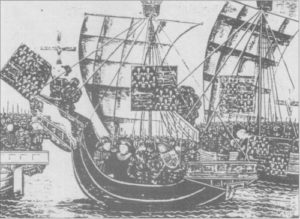- Author
- Chaloner
- Subjects
- History - general
- Tags
-
- RAN Ships
- None noted.
- Publication
- August 1999 edition of the Naval Historical Review (all rights reserved)
Financing Sluys
We have to remember that medieval society in England and Western Europe was governed by the feudal system. William of Normandy, eventually also King of England, was a vassal of the French King to whom he had to render his allegiance. Edward III in respect of Guenne and Gascony (Normandy having been lost by King John), had to do homage to the French King. The Normans introduced feudalism to England with the monarch ruling as liege lord. However, members will recollect that in 1215 at Runnymede the barons had imposed a certain degree of control. A parliament had to be consulted before the monarch could raise taxes, which covered the provision of men as well as money and goods. So Edward summoned his peers, consisting of 40 barons and 30 clergy. These chaps, suffering from previous demands on their purses to fight the Scots and the French in addition to the escalating costs of maintaining a chivalric, knightly style of life advised his Majesty to include the rich merchants in the discussion.
They met in Westminster Hall. Initially the landed gentry in one room were addressed as to the Royal needs. This was of course, the House of Lords. On that day in 1339, for the first time, the Lords arose and moved to another room to put the case to the burgesses thus establishing the English bicameral parliamentary system.
The Lords retired and the burgesses stayed on to discuss the means whereby Edward III could be financed for his war which commenced with the Battle of Sluys. The origin of the House of Commons belongs to Sluys.
Budget Approved – Preparation for Sluys
In 1340 the Royal Navy could not claim the later proud distinction of being the senior service, for it functioned mainly as a subsidiary of the army. Its chief service lay in the transporting of men, provisions, horses and other supplies. Its worth was negative or defensive until the battle of Sluys.
Sir Nicholas Harris Nicholas (“A History of the Royal Navy”, London, 1847) reports that there was only a small nucleus of a permanent fleet; some 15 royal ships including 3 cogs, 3 galleys, and 3 barges and 15 master mariners on the King’s payroll. We know that the cogs were the Christopher, Edward and Thomas. The great cogs Christopher and Edward were captured by French privateers before Sluys.

In 1339, Edward issued orders for the “arrest” in harbours of all ships above a stipulated tonnage, usually 40 or 50 tons. These were all merchantmen and they were impressed totally for the duration. No hiring fees were paid and if the ship was lost no compensation. Nor was that all. Once requisitioned, vessels had to be adapted for military purposes. A ship which was to be used for conveying horses abroad had to have hurdles fitted into the holds – substantial because a war horse was built not to pull a trotting gig, but to carry a knight in an iron harness so heavy that it took the exertion of a couple of squires to hoist him aboard. If the ship was intended for battle, castles were built fore and aft for men-at-arms and a turret high on the mast to accommodate archers.
The favoured vessel was the cog; a comparatively new design of stout construction and ample breadth of hull to provide good cargo space. In 1340 most cogs carried a single mast and sail and were often steered by oar, the rudder being a new invention.
King Edward called on the barons of the Cinque Ports for the 21 ships of the fleet they were bound by their Charter to render. But he took time to collect some other ships at Dartmouth, and those men of the Cinque Ports who were waiting at Winchelsea, and were growing impatient, took matters into their own hands. They sailed off to attack shipping in the harbours at Le Treport and Boulogne, set the latter town on fire and burnt four “grete shippes” and 19 galleys before sailing home with French captains hanging from their yardarms. It seemed to be enough reprisal for the time being.
Later, however, in midsummer of 1340, and after French depredations on the Kent coast, they formed a part of the fleet which Edward commanded in person.




